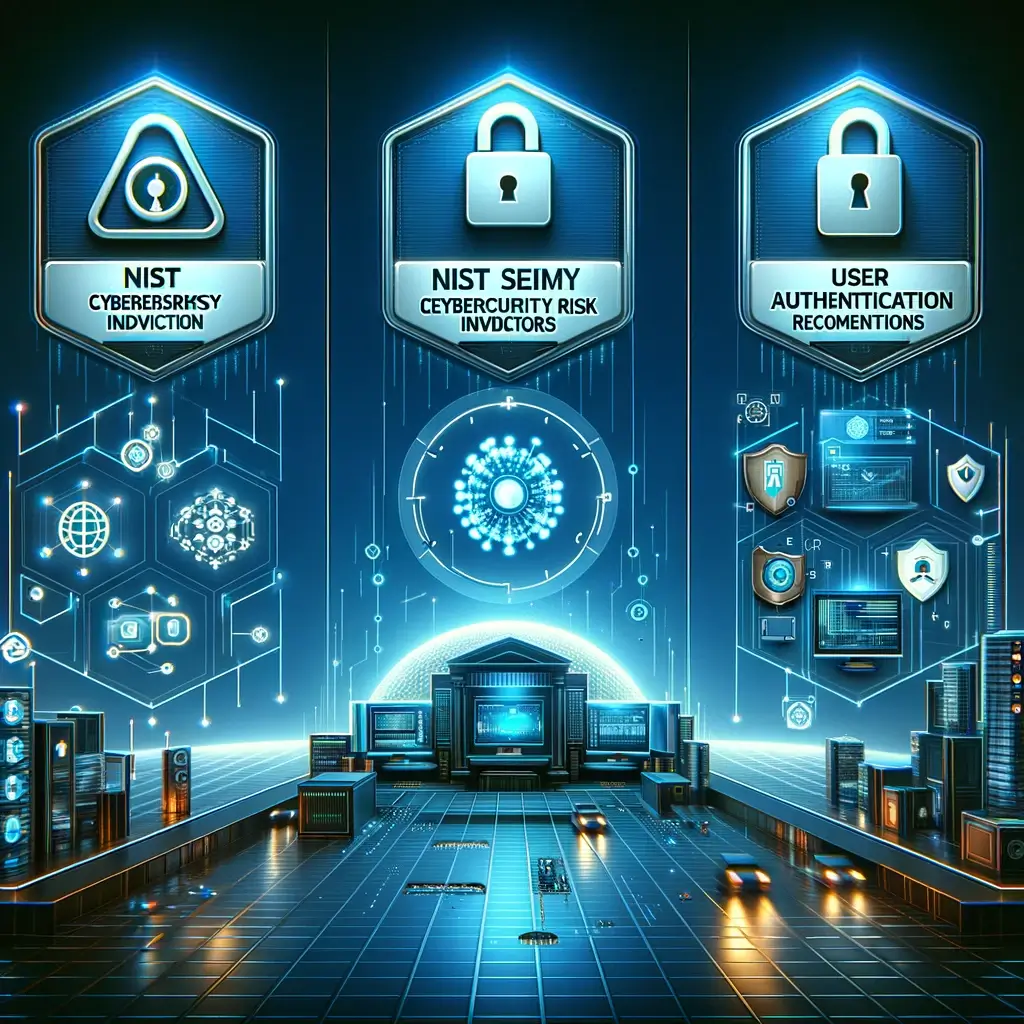NIST Cybersecurity Key Risk Indicators are essential for organizations to identify and reduce risks. These indicators provide a way to measure and track the effectiveness of cybersecurity controls and identify potential vulnerabilities.
In this article, we will discuss the three best examples of NIST Cybersecurity Key Risk Indicators that organizations can use to improve their cybersecurity posture.
The first example of a NIST Cybersecurity Key Risk Indicator is the level of preparedness. This KRI measures an organization’s readiness to respond to a cyber attack.
It includes factors such as incident response planning, employee training, and security testing. Organizations can use this KRI to pinpoint areas for improvement and corrective action.
The second example of a NIST Cybersecurity Key Risk Indicator is the number of security incidents. This KRI measures the frequency and severity of security incidents, such as data breaches or malware infections. Organizations can prevent future security incidents by tracking KRIs to identify patterns.
The third example of a NIST Cybersecurity Key Risk Indicator is the effectiveness of security controls. This KRI measures the effectiveness of an organization’s security controls in preventing and detecting cyber attacks.
It includes factors such as patch management, access controls, and network segmentation. By tracking this KRI, organizations can identify areas where their security controls need improvement and take corrective action to reduce the risk of a cyber attack.
Understanding NIST Cybersecurity Key Risk Indicators
NIST Cybersecurity Key Risk Indicators (KRIs) are essential metrics that help organizations to track and measure the effectiveness of their cybersecurity programs.
KRIs are leading indicators of risk that provide early warning signs of potential security breaches, allowing organizations to take proactive measures to mitigate risks.
NIST has developed a comprehensive set of guidelines and standards for cybersecurity KRIs. These guidelines provide a framework for identifying, selecting, and implementing KRIs that are relevant to an organization’s specific security needs.
The guidelines also provide recommendations for measuring and reporting on KRIs to ensure they effectively reduce risk.
Organizations can use KRIs to monitor a range of security risks, including external threats, internal vulnerabilities, and compliance risks.
KRIs can be used to track the effectiveness of security controls, identify emerging threats, and measure the impact of security incidents on the organization.
Some of the best examples of NIST Cybersecurity Key Risk Indicators include:
- Number of successful phishing attacks: This KRI measures the number of successful phishing attacks that have occurred within an organization. Phishing attacks are a common form of social engineering that can be used to gain unauthorized access to sensitive information. By tracking the number of successful phishing attacks, organizations can identify areas of weakness in their security controls and take proactive measures to prevent future attacks.
- Patch compliance rate: This KRI measures the percentage of systems within an organization that are up-to-date with the latest security patches. Patching is an essential part of maintaining the security of an organization’s IT infrastructure. By tracking patch compliance rates, organizations can identify systems that are at risk of being exploited by cybercriminals and take corrective action to mitigate the risk.
- Number of security incidents: This KRI measures the number of security incidents that have occurred within an organization. Security incidents can include data breaches, malware infections, and unauthorized access to systems. By tracking the number of security incidents, organizations can identify trends and patterns in security incidents and take proactive measures to prevent future incidents.
NIST Cybersecurity Key Risk Indicators are an essential tool for organizations to measure and monitor the effectiveness of their cybersecurity programs.

Organizations can identify and mitigate security risks through the selection and implementation of relevant KRIs.
Top Three Examples of NIST Cybersecurity KRIs
NIST Cybersecurity Key Risk Indicators (KRIs) are essential tools that help organizations monitor and evaluate their cybersecurity posture. KRIs provide organizations with a forward-looking view of their cybersecurity risks, enabling them to identify potential threats and take proactive measures to mitigate them.
In this section, we will discuss the top three examples of NIST Cybersecurity KRIs that organizations can use to manage their cybersecurity risks.
Example 1: Risk Management Framework
The NIST Risk Management Framework (RMF) is a comprehensive approach to managing cybersecurity risks that provides a structured, repeatable process for organizations to follow.
The RMF consists of six steps: (1) categorize the information system and the information processed, stored, and transmitted by the system; (2) select the appropriate set of security controls for the system; (3) implement the security controls and document how they are implemented; (4) assess the effectiveness of the security controls; (5) authorize the information system to operate; and (6) monitor the security controls on an ongoing basis.
One of the key KRIs in the RMF is the percentage of security controls that are implemented. This KRI measures the organization’s progress in implementing the security controls identified in the RMF and provides an indication of the organization’s cybersecurity posture.
The higher the percentage of security controls implemented, the better the organization’s cybersecurity posture.
Example 2: Cybersecurity Framework
The NIST Cybersecurity Framework (CSF) is a voluntary framework that provides a common language and a set of guidelines for organizations to manage and reduce their cybersecurity risks. The CSF consists of five functions: (1) identify, (2) protect, (3) detect, (4) respond, and (5) recover.
One of the key KRIs in the CSF is the number of cybersecurity incidents detected. This KRI measures the effectiveness of the organization’s cybersecurity controls in detecting and responding to cybersecurity incidents. The lower the number of cybersecurity incidents detected, the better the organization’s cybersecurity posture.
Example 3: NISTIR 8286
NISTIR 8286 is a guide for developing cybersecurity performance metrics that organizations can use to measure the effectiveness of their cybersecurity programs.
The guide provides a framework for developing metrics that are aligned with the organization’s goals and objectives and that provide meaningful insights into the organization’s cybersecurity posture.
One of the key KRIs in NISTIR 8286 is the percentage of critical assets that are protected. This KRI measures the organization’s progress in protecting its critical assets, which are the assets that are essential to the organization’s mission and that would cause significant harm if they were compromised.
The higher the percentage of critical assets protected, the better the organization’s cybersecurity posture.
NIST Cybersecurity KRIs are essential tools that organizations can use to manage their cybersecurity risks. The top three examples of NIST Cybersecurity KRIs discussed in this section are the percentage of security controls implemented in the RMF, the number of cybersecurity incidents detected in the CSF, and the percentage of critical assets protected in NISTIR 8286. Organizations can proactively mitigate cybersecurity risks by monitoring these KRIs.
Role of KRIs in Cybersecurity Risk Management
Key Risk Indicators (KRIs) are critical components of cybersecurity risk management that enable organizations to identify, measure, and monitor potential risks.
KRIs are specific metrics that provide early warning signs of potential risks and help organizations take proactive measures to mitigate them.
KRIs are typically used in conjunction with Key Performance Indicators (KPIs) to provide a comprehensive view of an organization’s risk exposure.
KRIs play a crucial role in cybersecurity risk management by providing valuable insights that enable organizations to make informed decisions.
Organizations use Key Risk Indicators (KRIs) to identify and measure potential risks, enabling them to make informed decisions about their risk exposure.KRIs also help organizations to prioritize their risk management efforts and allocate resources effectively.
Effective governance is essential for successful cybersecurity risk management, and KRIs play a critical role in this process. KRIs enable organizations to establish clear risk management objectives, measure progress towards these objectives, and make informed decisions about risk management strategies.
KRIs also provide valuable information that enables organizations to communicate effectively with stakeholders and make informed decisions about resource allocation.

Enterprise Risk Management (ERM) is a critical component of successful cybersecurity risk management, and KRIs play a crucial role in this process. KRIs enable organizations to identify potential risks across the enterprise, measure risk exposure, and make informed decisions about risk management strategies.
Organizations can make informed decisions about risk by integrating KRIs into ERM processes.
KRIs are critical components of effective cybersecurity risk management. By identifying potential risks, measuring risk exposure, and providing valuable insights, KRIs enable organizations to make informed decisions about risk appetite, prioritize risk management efforts, and allocate resources effectively.
Effective governance and enterprise risk management are essential for successful cybersecurity risk management, and KRIs play a crucial role in these processes.
How Organizations Implement and Utilize KRIs
KRIs are essential tools for organizations to identify, detect, and recover from cybersecurity threats. By implementing and utilizing KRIs, organizations can measure and manage their cybersecurity risk more effectively. This section will discuss how organizations can implement and utilize KRIs to improve their cybersecurity posture.
Identifying KRIs
The first step in implementing KRIs is to identify the most relevant and effective indicators for your organization. This can be done by assessing your organization’s unique cybersecurity risks and vulnerabilities.
Once you have identified the most relevant KRIs, you can begin to implement them into your cybersecurity risk management strategy.
Detecting Cybersecurity Threats
KRIs can help organizations detect cybersecurity threats more efficiently. Organizations can proactively detect potential cybersecurity threats before they cause significant damage by monitoring Key Risk Indicators (KRIs).
This enables organizations to take proactive measures to mitigate the risk and prevent data breaches.
Recovering from Cybersecurity Incidents
KRIs can also help organizations recover from cybersecurity incidents more efficiently. By monitoring KRIs, organizations can quickly identify and respond to cybersecurity incidents, minimizing the damage and reducing recovery time.
This helps organizations get back to normal operations more quickly, reducing the impact on business operations.
Reporting to Boards of Directors
KRIs are also an essential tool for reporting to boards of directors. By providing regular reports on cybersecurity risk management, organizations can keep boards of directors informed and ensure they are aware of the organization’s cybersecurity risks.
This helps boards of directors make informed decisions and ensures that cybersecurity risk management is a priority for the organization.
Collaboration and Automated Measures
KRIs can also facilitate collaboration between different departments and teams within an organization. By providing a common language and framework for measuring and managing cybersecurity risk, KRIs can help teams work together more effectively.
Additionally, automated measures can help organizations monitor KRIs more efficiently, freeing up resources for other cybersecurity tasks.
Regulatory Compliance and GRC
KRIs can also help organizations achieve regulatory compliance and improve their overall governance, risk management, and compliance (GRC) posture.
Organizations can use KRIs to demonstrate serious cybersecurity risk management and protect sensitive data.
KRIs are essential tools for organizations to measure and manage their cybersecurity risk effectively.
Organizations can enhance their cybersecurity posture, report to boards of directors, collaborate effectively, achieve regulatory compliance, and improve GRC posture by implementing and utilizing KRIs.
Key Performance Indicators vs Key Risk Indicators
In cybersecurity, it is important to measure the effectiveness of the security program and identify potential risks that could impact the organization. Two metrics that are commonly used are Key Performance Indicators (KPIs) and Key Risk Indicators (KRIs).
Key Performance Indicators (KPIs) are a set of metrics that help organizations measure the success of their security program.
They are used to evaluate security controls’ performance and identify improvement areas. KPIs are typically used to measure the effectiveness of security controls, such as the number of incidents detected, the time taken to respond to incidents, and the percentage of vulnerabilities remediated.
Key Risk Indicators (KRIs) are a set of metrics that help organizations identify potential risks that could impact the organization.
KRIs are used to measure the level of risk exposure and provide early warning signs of potential security incidents. KRIs are typically used to measure the likelihood and impact of security incidents, such as the number of failed login attempts, malware infections, and unauthorized access attempts.
While KPIs and KRIs are both used to measure the effectiveness of security controls, they serve different purposes. KPIs are used to measure the performance of security controls, while KRIs are used to identify potential risks.
Organizations should use both KPIs and KRIs to ensure that their security program is effective and that potential risks are identified and mitigated.
In summary, KPIs and KRIs are both important metrics that organizations should use to measure the effectiveness of their security program and identify potential risks.
Organizations can use KPIs and KRIs to identify and mitigate risks to ensure effective security programs.
The Impact of KRIs on Information Security
KRIs play a critical role in identifying and mitigating cybersecurity risks. Information security is a top priority for organizations, and KRIs can help protect sensitive data from cyber-attacks.
Tracking key risk indicators (KRIs), CIOs and IT security professionals can identify vulnerabilities and implement security policies to protect against threats.
KRIs provide a way to measure the effectiveness of an organization’s cybersecurity program. Organizations can detect security threats by analyzing cyber incident trends.
KRIs can also help organizations identify areas where they may be overexposed to risk and take corrective action.
One of the key benefits of KRIs is that they provide a way to communicate the impact of cybersecurity risks to senior management.
IT security professionals can demonstrate the importance of information security and the need for additional resources to protect against cyber threats by presenting clear and concise KRIs.
KRIs are an essential tool for protecting sensitive data and mitigating cybersecurity risks. By tracking KRIs, organizations can identify vulnerabilities, implement security policies, and communicate the impact of cybersecurity risks to senior management.
KRIs in Incident Response and Disaster Recovery
KRIs play a crucial role in incident response and disaster recovery. When a cyber incident occurs, the ability to respond quickly and effectively can be the difference between a minor disruption and a major data breach.
KRIs can help organizations identify potential vulnerabilities and take proactive steps to mitigate them.
For example, one KRI that can be used to monitor incident response effectiveness is the mean time to detect (MTTD) a cyber incident. This metric measures the time it takes for an organization to detect a security incident and can help identify areas where incident response processes can be improved.
Organizations can proactively address potential incident response plan gaps by monitoring MTTD.
Another KRI that can be useful in incident response and disaster recovery is the meantime to respond (MTTR) to a cyber incident. This metric measures the time it takes for an organization to respond to a security incident and can help identify areas where response times can be improved.
Organizations can identify bottlenecks in incident response by monitoring MTTR and proactively addressing them.
Finally, KRIs can also be used to monitor the effectiveness of disaster recovery plans. For example, one KRI that can be used to monitor disaster recovery effectiveness is the recovery point objective (RPO).
This metric measures the maximum amount of data loss that an organization can tolerate during a disaster. Organizations can proactively address disaster recovery gaps by monitoring RPO.
KRIs are an essential tool for organizations looking to improve their incident response and disaster recovery processes. By monitoring key metrics like MTTD, MTTR, and RPO, organizations can identify potential vulnerabilities and take proactive steps to mitigate them.
This can help organizations respond more quickly and effectively to cyber incidents, reduce the risk of data breaches, and protect sensitive data from unauthorized access.
The Role of KRIs in Regulatory and Legal Aspects
Key Risk Indicators (KRIs) are essential for organizations to measure and monitor the effectiveness of their cybersecurity programs. KRIs can help organizations identify potential risks and vulnerabilities and take proactive measures to mitigate them.
This is especially important in regulatory and legal aspects, where non-compliance can result in significant financial and reputational damage.
Regulatory compliance is a critical aspect of cybersecurity, and KRIs can help organizations meet regulatory requirements.
For example, in the financial industry, KRIs can help organizations monitor compliance with regulations such as the Gramm-Leach-Bliley Act (GLBA) and the Sarbanes-Oxley Act (SOX).
Kris can also help organizations ensure compliance with industry standards such as the Payment Card Industry Data Security Standard (PCI DSS) and the Health Insurance Portability and Accountability Act (HIPAA).
In addition to regulatory compliance, KRIs can also play a crucial role in legal aspects. KRIs can help organizations identify potential legal risks and take proactive measures to mitigate them.
For example, KRIs can help organizations monitor and prevent data breaches, which can result in legal action from affected parties.
Privacy is another critical aspect of cybersecurity, and KRIs can help organizations protect sensitive data. KRIs can help organizations monitor compliance with privacy regulations such as the General Data Protection Regulation (GDPR) and the California Consumer Privacy Act (CCPA).
KRIs are an essential part of cybersecurity risk management. They can help organizations identify potential risks and vulnerabilities, monitor compliance with regulatory and legal requirements, and take proactive measures to mitigate risks.
Effective implementation of KRIs can enhance cybersecurity and safeguard against financial and reputational harm.

Conclusion
NIST Cybersecurity Key Risk Indicators (KRIs) are an essential part of any organization’s risk management framework. By using KRIs, organizations can measure the effectiveness of their cybersecurity measures and identify potential vulnerabilities and threats.
Through the use of KRIs, organizations can set objectives and standards for their cybersecurity measures and measure their performance against those objectives.
This can help organizations identify areas where they need to improve their cybersecurity measures and ensure that they are meeting regulatory and legal requirements.
The taxonomy of KRIs can be used to help organizations to identify and prioritize their cybersecurity risks, and to develop appropriate measures to mitigate those risks.
Organizations can effectively manage risk by collaborating with their boards, CISOs, and IT security professionals to develop strategies that align with their risk appetite and exposure.
To ensure the effectiveness of their cybersecurity measures, organizations must also have appropriate incident response and disaster recovery plans in place.
This can help them to respond quickly and effectively to any cybersecurity incidents or data breaches, and to minimize the impact of those incidents on their business operations.
The use of NIST Cybersecurity Key Risk Indicators can help organizations improve their cybersecurity posture, protect sensitive data, and reduce their business risk.
Collaborating with regulatory bodies and adopting industry standards and best practices, organizations can meet their cybersecurity objectives and protect their customers’ privacy and financial information.

Chris Ekai is a Risk Management expert with over 10 years of experience in the field. He has a Master’s(MSc) degree in Risk Management from University of Portsmouth and is a CPA and Finance professional. He currently works as a Content Manager at Risk Publishing, writing about Enterprise Risk Management, Business Continuity Management and Project Management.


